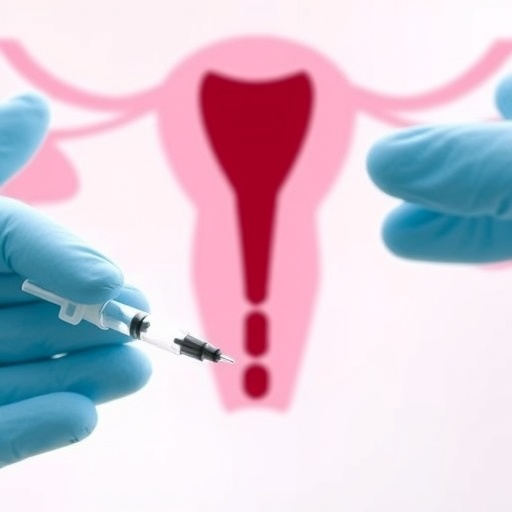In a groundbreaking study led by Lee, T. and their colleagues, the potential of innovative medical devices designed for the treatment of cervical neoplasia in underserved regions has been explored. With a focus on the usability of speculum-compatible injection devices, this research delves into an essential area of cervical health that affects millions of women across low- and middle-income countries. The prevailing need for cost-effective, efficient treatments makes this work not just timely but urgent.
Cervical neoplasia, often a precursor to cervical cancer, inflicts a heavy burden on women, particularly in areas with limited healthcare resources. Traditional treatment methods are often not feasible in these countries due to cost, accessibility, and lack of trained healthcare personnel. This study comes at a crucial time when the global health community is seeking effective solutions to prevent cervical cancer and improve women’s health.
The research team employed a series of rigorous tests to evaluate the usability of various speculum-compatible injection devices. These devices are designed to administer ethyl cellulose and ethanol ablation—a treatment known for its efficacy and relative simplicity when it comes to application. Ethyl cellulose is particularly noted for its biocompatibility, making it suitable for injection during procedures aimed at eradicating abnormal cervical tissue.
A key aspect of the study was the emphasis on user experience and practical application in low-resource settings. The research investigated how well-trained healthcare workers could effectively use these devices in real clinical scenarios. This aspect of usability is critical since the ultimate goal is to ensure that interventions are not only developed but also adopted in practice. The focus on usability aims to bridge the gap between innovation and implementation, which has historically hindered the rollout of medical technologies in such settings.
Moreover, the injection devices investigated were selected based on their potential to minimize the discomfort for patients while maximizing treatment efficacy. Delivering effective interventions without imposing additional burdens on patients is a vital consideration in resource-limited environments. This approach can dramatically improve patient compliance and outcome success rates.
The study’s findings showed that the speculum-compatible devices were not only user-friendly but also allowed for easier access to the cervix, which is crucial for effective treatment. The ergonomics and design of the devices were specifically tailored to accommodate the needs of healthcare providers operating in low-resource facilities. This thoughtful design consideration aligns with the overarching goal of increasing the accessibility of effective cervical cancer treatments.
Additionally, the researchers monitored the devices’ performance in simulated environments that closely mimic real-world conditions. The ability to provide realistic training scenarios will empower clinicians to become proficient in using the devices before they encounter patients. Such preparatory measures are essential for minimizing complications during procedures and ensuring high-quality patient care.
With a renewed focus on cervical health, the outcomes of this study could influence future research and investment in medical technology for neglected health issues. As the demand for accessible healthcare options continues to rise, this line of inquiry highlights an essential niche that requires urgent attention and action. The implications are broad; if successful, this approach could serve as a model for developing medical solutions for other prevalent health issues in low- and middle-income countries.
This research also brings into question the broader landscape of healthcare innovation. The findings encourage discussions around how to accelerate the development and distribution of affordable medical devices. Making cutting-edge technology accessible could radically transform health outcomes for underserved populations, pushing us closer to equity in healthcare.
As global health organizations and governments strive to incorporate more innovative strategies into their healthcare systems, the insights gained from this study will prove invaluable. The potential success of speculum-compatible injection devices exemplifies how tailored solutions can address pressing health challenges while considering the unique contexts in which they will be deployed.
In conclusion, this research represents a significant step forward in women’s health, particularly for those in low- and middle-income countries grappling with the dire effects of cervical neoplasia. By blending scientific innovation with usability, the study champions a practical approach to health interventions that promise to enhance treatment accessibility and efficacy. As the world continues to battle preventable diseases, this study serves as a beacon of hope and a clarion call for increased focus on research that meets the needs of the most vulnerable populations.
The project’s outcome is not merely a triumph of design and functionality; it is a moral imperative that advocates for equitable health solutions. This research captures an urgent message that innovation in healthcare should not come at the expense of accessibility. The study portrays a future where no woman is deprived of the necessary care for cervical health due to geographic or economic barriers.
Through continuous evaluation and development of healthcare technologies such as the speculum-compatible injection devices, we can work towards an empowered global health community that prioritizes women’s health. As more studies like this arise, we inch closer to a world where effective treatment for cervical neoplasia is not a privilege but a standard accessible to all.
Subject of Research: Usability of speculum-compatible injection devices for cervical neoplasia treatment.
Article Title: Usability of Speculum-Compatible Injection Devices for Administering Ethyl Cellulose-Ethanol Ablation to Treat Cervical Neoplasia in Low- and Middle-Income Countries.
Article References:
Lee, T., Richardson-Powell, V., Chen, J. et al. Usability of Speculum-Compatible Injection Devices for Administering Ethyl Cellulose-Ethanol Ablation to Treat Cervical Neoplasia in Low- and Middle-Income Countries.
Ann Biomed Eng (2025). https://doi.org/10.1007/s10439-025-03799-8
Image Credits: AI Generated
DOI: 10.1007/s10439-025-03799-8
Keywords: cervical neoplasia, usability, injection devices, ethyl cellulose, ethanol ablation, low-income countries, women’s health, healthcare innovation.




